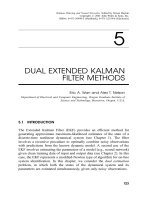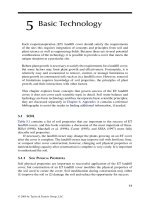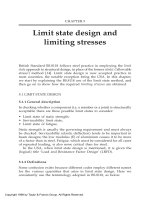CHAPTER 5 INFINITE SEQUENCES AND SERIES SERIES
Bạn đang xem bản rút gọn của tài liệu. Xem và tải ngay bản đầy đủ của tài liệu tại đây (1.43 MB, 30 trang )
CHAPTER 5
INFINITE SEQUENCES
AND SERIES
CONTENTS
5.1. Sequences
5.2. Series
5.3. The Integral and Comparison Test
5.4. Other Convergence Test
5.5. Power Series
5.6. Representations of Functions as Power Series
5.7. Taylor and Maclaurin Series
5.8. The Binomial Series
5.9. Applications of Taylor Polynomial
5.10. Using Series to solve Differential Equations
5.11. Fourier Series
5.2. SERIES
5.2.1. The Sum of a Series
5.2.2. Geometric Series
5.2.3. The Test for Divergence
5.2.4. Properties of Convergent Series
5.2.1 The Sum of a Series
We can add the terms of a sequence {an } and
get an expression of the form:
a1+ a2+ a3+ …+ an + …
which is called a series and denoted by
a
n 1
n
or
a
n
However what does it mean by the sum of
infinitely many terms?
Example. We can try to add the terms of the series
1+2+3+…+n+…
and get the cumulative sums
1, 3, 6, 10, …,
The nth sum n(n+1)/2 becomes very large as n increases
On the other hand if we add the terms of the series
1 1 1
1
n
2 4 8
2
we get the cumulative sums
1 3 7
1
, , , ,1 n ,
2 4 8
2
The nth sum 1-1/2n becomes closer and closer to 1
as n increases infinitely
We may say that the sum of this infinite series is 1 in
the following sense:
Definition. Given a series
n 1
an a1 a2 an
Let sn denote the nth partial sum
n
sn ai a1 a2 an
i 1
If lim sn s exists as a real number, we say that
n
the series is convergent and write
n 1
an a1 a2 an s
otherwise, it is divergent. This number s is called
the sum of the series
So now we can write
1
1 1
1
n1 2 n 2 4 2 n 1
Note. The fact that a series is convergent or not does
not change if we suppress a finite number of terms.
5.2.2 The Geometric Series
Let's consider the geometric series
a ar ar n 1 ar n 1
n 1
a0
5.2.2 The Geometric Series
Let's consider the geometric series
a ar ar n 1 ar n 1
a0
n 1
If r = 1, then the nth sum sn=na as n .
Hence the geometric series is divergent
If r 1, then we have
sn a ar ar 2 ar n 1
and
Hence
rsn
ar ar ar
2
sn-rsn = a - arn
n 1
ar
n
sn-rsn = a - arn
a (1 r n )
sn
1 r
If –1
a
a
a
n
lim sn lim
lim r
n
n
1 r
1 r 1 r n
1 r
Thus the geometric series is convergent; its sum is
a
s
1 r
If r –1 or r >1, then {rn} is divergent so the limit
of sn as n does not exist. Thus the geometric
series is divergent
The geometric series
n 1
n 1
ar
a
ar
ar
n 1
is convergent if r < 1 and its sum is
a
n 1
ar
1 r
n 1
if r 1, the geometric series is divergent
Example. Find the sum of the geometric series
40
5 103 209 27
The geometric series
n 1
n 1
ar
a
ar
ar
n 1
is convergent if r < 1 and its sum is
a
n 1
ar
1 r
n 1
if r 1, the geometric series is divergent
Example. Find the sum of the geometric series
40
5 103 209 27
Solution. We have a=5, r=-2/3. Since r < 1 the
series is convergent with the sum
5
5
10
20
40
5 3 9 27
5 3
2
1 ( 3 ) 3
Example. Is the series
2 n 1 n
2
3
n 1
convergent?
Example. Is the series
2 n 1 n
2
3
n 1
convergent?
Solution. We rewrite the nth term of the series in
the form
n 1
n
4
4
2 n 1 n
2 3 n 1 4
3
3
Therefore the series is a geometric series with a=4
and r = 4/3 > 1 so it is divergent
Example. Write 2.317 2.3171717... as a fraction
Example. Write 2.317 2.3171717... as a fraction
Solution. We may write
17 17 17
2.3171717... 2.3 3 5 7
10 10 10
Apart from the first term 2.3, the rest is the sum of
a geometric series with a=17/103 and r = 1/102 < 1
so it is convergent, and we have
17
1
17 1
2.317 2.3 3
2.3
99
1
10 1 102
1000 100
23 17 1147
10 990 495
Example. Find the sum of the series
n
x
, where x 1
n 0
Example. Find the sum of the series
n
x
, where x 1
n 0
Solution. This is a geometric series with a=1 and
r = x . Since r < 1, the series is convergent; its sum is
1
n
x
1 x
n 0
Example. Find the sum of the series
1
n 1 n( n 1)
Solution. This is not a geometric series but we can
write the partial sum as
n
1
1 1
sn
i 1
i 1 i (i 1)
i 1 i
n
1
1
1 1 1 1 1
1
1
1
n 1
2 2 3 3 4
n n 1
1
Now lim sn 1 lim
1 0 1
n
n n 1
Therefore the series is convergent with the sum
1
1
n 1 n( n 1)
Example. Determine whether the series is
convergent or divergent. If the series is convergent,
find its sum.
a.
∞
𝑛=1
b.
1
1.4
−3 𝑛−1
23𝑛
1
+
4.7
+ ⋯…..+
1
3𝑛−2 3𝑛+1
+ ⋯…..
Example. Expressing the repeating decimal
0.9999999 (or 4.17326326326)….. as a fraction.
5.2.3 The Test for Divergence
Theorem 1. If the series
then
lim a 0
n
a
n 1
n
is convergent,
n
Proof. Let sn = a1 + a2 + … + an. Then an = sn – sn-1 .
Hence
lim an lim( sn sn 1 ) lim sn lim sn 1 s s 0
n
n
n
n
Note. The converse of Theorem 1 is not true as
shown by the following example
1
It is clear that lim 0
n n
However we will see later that the harmonic series is
divergent
1
1 1
1
1
2 3
n
n 1 n
an
The Test for Divergence. If lim
n
an 0 , then the series
or lim
n
Example. Show that the series
is divergent
does not exist
a
n 1
n
is divergent
n2
2
5
n
4
n 1
an
The Test for Divergence. If lim
n
does not exist
a
an 0 , then the series
or lim
n
n 1
Example. Show that the series
is divergent
n
is divergent
n2
2
5
n
4
n 1
Solution. We have
n2
lim 2
n 5n 4
1
1
lim
0
n
4 5
5 2
n
Therefore the series is divergent by the Test for
Divergence









